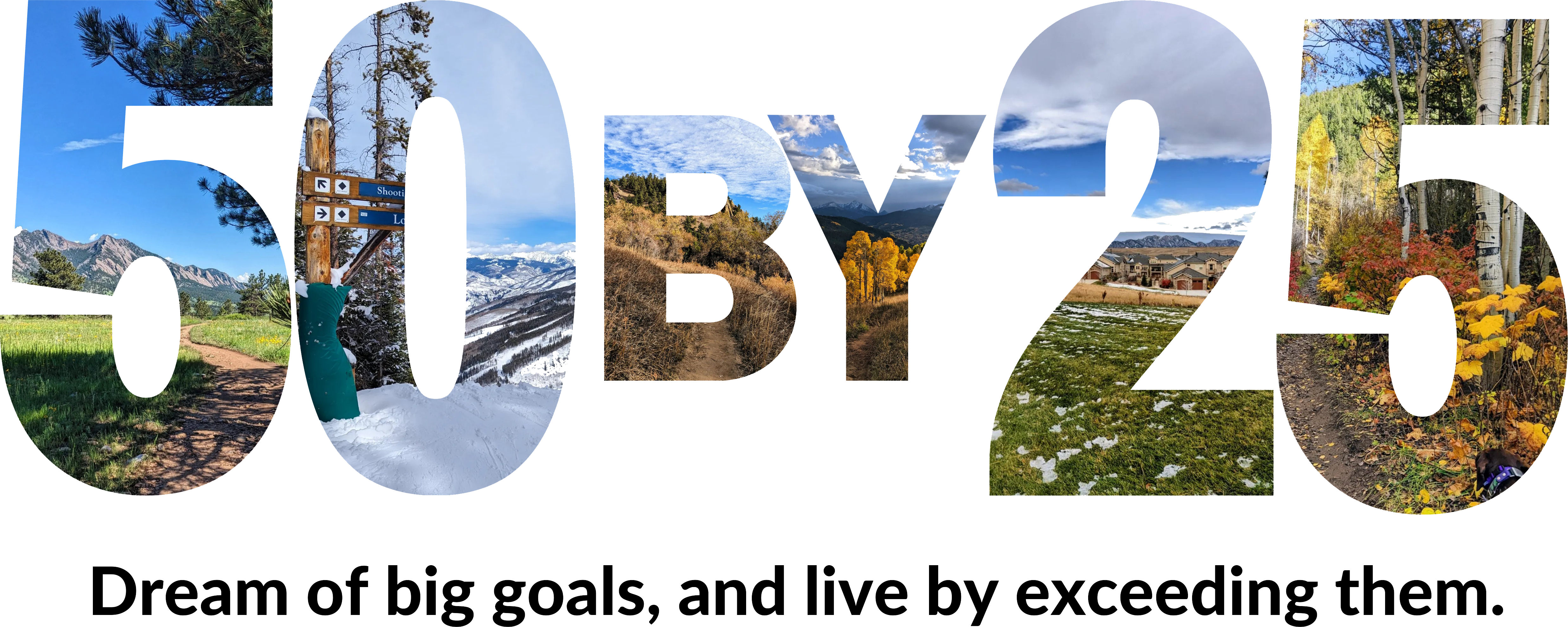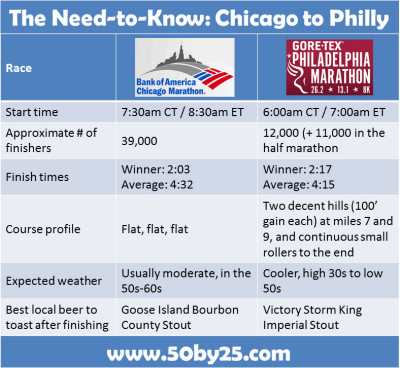There’s been a lot of great weather for racing lately – Chicago was held on a near perfect day (where the winner was less than a minute from the marathon world record!), and I also just ran the Hartford Marathon that weekend which was similarly lovely. However, sometimes even when the weather is perfect, it’s just not your day… and you want to run another race. (Or, maybe you had so much fun you can’t wait to do it again!) I ran my second marathon six weeks after my first marathon (and my third one week after that!), and since I often run marathons close together, I’ve been getting a lot of tweets/emails/texts from friends wanting to know how to train if they’re going to do another marathon quickly. The most frequently asked about pair has been Chicago Marathon (October 13) to Philly Marathon (November 17), so I decided to put together a training plan for that five week break.
Chicago and Philly are both huge races – drawing more than 20,000 people to each – but there are a lot of key differences. Here’s a quick chart to summarize the key facts:
Size: Philly is definitely a lot smaller than Chicago, but the only place you’ll really feel that is in how long it takes you to cross the start. Otherwise, both are mega-marathons where you’ll never be alone, and there are thousands of fans screaming you on.
Pace: Although the average pace seems to be much faster for the Philadelphia Marathon, it’s actually because of skews in it being run by many faster runners and not as many slower runners. The winning Philadelphia finish time last year was 2:17 – compare that to this year’s Chicago win of 2:03 and you can see it’s a much tougher course! Philadelphia only had about 6% of their runners finish slower than 5:30 in 2012, whereas Chicago had 15% of their runners in this range – accounting for the difference in average finish time. But don’t worry – although both races technically have a 7:00 cutoff, each has logged slower finish results than that. Just keep trucking and you’ll get your medal!
Course profile: This is where the two races really differ. Although both have minimal net elevation change, Chicago is flat as a pancake with literally no hills of consequence (sorry, the little blips you see on the Chicago elevation chart are all short and less than 20 feet of gain each, and really don’t count as hills). Philadelphia, on the other hand, has two decent hills (100 feet of elevation gain each) at miles 7 and 9, and then continuous small rollers from there to the end. Before you panic, though, remember that running hills can actually be good for you in a marathon – it changes the muscles up in your legs so you’re less likely to cramp up than continually pounding the exact same muscle fibers the whole way. However, to account for this course difference, you definitely want to incorporate some solid strength training and hillwork into the month between the races. The plan I’ve put together is minimal on speedwork, and if possible, try to do your long slow distance runs on a route that traverses some hills.
Expected weather: Although you can never be sure until you start seeing the forecasts, Philly is generally a lot colder than Chicago – so dress in layers. This should help you, though, not hurt you! Get excited.
Beer: What race training plan would be complete without a plan for where you’re going to toast a cold one to your accomplishments post-race? Goose Island and Victory are two quality breweries in Chicago and (just outside) Philly, respectively, whose beers shouldn’t be hard to find even if you choose to limp only as far as the pub under your hotel 🙂
So now that you’re pumped, ready for the training plan? I’ve put together a simple Excel workbook with two tabs – one that has the plan (and some important reminders about how to use it), and the second sheet is for you to track your workouts and chart how you’re feeling during (RPE = rate of perceived exertion) and after each one. If things didn’t go perfectly for you in Chicago, tracking your workouts can help you see what works and what doesn’t so you can avoid whatever mistakes you made the first time. I didn’t include a column for food tracking, though you can certainly put that in the “Other notes” field, or add a column of your own. Just make sure you remember to fill out column I (“How did you feel the next day?”) to see what workouts are challenging you the most.
Depending on what kind of crosstraining you choose to do (elliptical, biking, Zumba, power yoga, etc – and feel free to mix it up with something different every time!), you may need to back off this in your final week before race day. Use column I to identify which workouts make you the most sore and how long that soreness lasts, then tweak the plan accordingly. Just remember that you do need a pretty hard session two days out from your race – that helps flush any remains of glycogen from your system in preparation for your two days of carb loading. (You are going low carb in the final week before your race to properly carb load, aren’t you?)
So without further ado: click here to download the Chicago to Philly Marathon Training plan.
One final note: although I’m not releasing this until 10/21 (since I didn’t start getting questions / decided to write this up until late last week!), the plan technically starts the day after the Chicago Marathon – albeit with a very light week. If you’re using it for this year’s Chicago to Philly, just start from today and fill in whatever you did do last week without worrying too much about it.
And of course, let me know if you have any additional questions or concerns in the comments – I’m happy to help tailor this to you!


If I was to consider providing a training plan for multiple races I would need some information. First, what is the goal? Is the goal to merely “finish” two races in six weeks or is the goal to do each race at “best effort”. That’s two different approaches. Second, I would want to know their training plan leading up to the first marathon as that gives me an idea of how many long runs (17 miles or more) I can put in the plan. At first blush I would say one; but that would depend what their last couple of weeks looked like going into the marathon.
What I don’t know is what would concern me. How quickly do they recover? Some runners recover quickly, others need more time. Do I need to give them one recovery week or two recovery weeks? That can make a big difference.
If I was making a plan for me (one that assumed I was going to run each race hard), it would be different, than yours. For example, I would build mileage at 8-12-21 versus 10-17-21, but that is because I get more out of (and need) that second week of recovery. I would also dump the speed work because one speed work session (or even three speed work sessions) isn’t going to benefit me in that short time period. My Thursday runs (after the recovery period) would be longer and would be tempo runs (finishing at race pace). All my Tuesday runs would be easy runs.
You make some great points – this definitely isn’t meant to be a fully customized plan! As you point out, individuals vary quite a bit; this is really just a cookie cutter program knowing that someone wants to run two marathons in six weeks, but not taking into account any other factors. Think of it like the basic plans on RunnersWorld.com – you take them and tweak them to fit what works for you.
One note about the speedwork: that’s not meant so much as to make you get faster, but more just to remind your legs what speed feels like (when the rest of the runs in the plan are hilly / easy / slow).